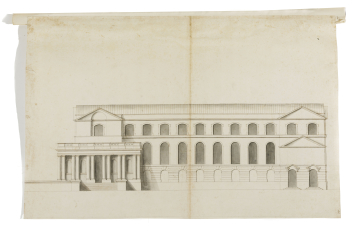
Browse
Reference number
Purpose
Aspect
Scale
Inscribed
Signed and dated
- Undated, but datable 1697-98
Medium and dimensions
Hand
Watermark
Notes
On this elevation and the one at All Souls (Geraghty 2007, no. 201) the pairs of columns are 7 feet across on average, which equals the spaces between the pairs. At the next stage in the design, [6/2], and in the fabric itself, the pairs of columns are only 5 ½ feet across, and the spaces remain 7 feet. The earlier stage corresponds to the plan of the colonnade in the four block scheme (All Souls, Geraghty 2007, no. 196), in which the colonnade itself is narrower in relation to the hall. Thus the hall and colonnade were revised together.
One of the factors influencing the design of the colonnade was its treatment on the north side of the hall, for in this drawing and the All Souls elevation, the colonnade functions as a portico-entrance on the north side. There is no indication in this drawing of a significant entrance on the east side, facing the central avenue. An approach from the north side may explain the infilling of the colonnade alongside the north wall of the hall. The left intercolumniation is backed by a wall with a niche, like the bays to the right. Unless this is a draughting error, this infilled bay indicates a previously unknown stage in the design in which the colonnade is closed off at its north end by an extension of the ground-floor wall of the hall.
The infilling of the colonnade alongside the north wall of the hall created a symmetrical north-facing portico, the central bay of which served as the principal entrance to the hall and the main route up to the higher level of the hospital site from King Charles II Court. Wren may have regarded the hall vestibule, rather than the colonnade, as the principal route from King Charles Court to the dormitories on the south side of the hall.
As the amendments to [6/2] show, the entrances to the hall on the north and east sides were later modifications. They appear to reflect a fundamental shift in the orientation of the plan. In the present drawing the centre of gravity is at the north end, with the main axis running from north to south. In [6/2] and subsequent designs the hall is approached from the west and east sides. Preparatory pencil lines at the west end of this drawing anticipate the two square-headed windows drawn at principal level on the end-bay of All Souls, Geraghty 2007, no. 201. The dome may have been omitted on grounds of cost. The accounts were in debt until the middle months of 1698, and 1697 was a particularly difficult year. Wren may have asked Hawksmoor to produce two variants of the hall design, one with, and one without a dome.
Literature
Level
Sir John Soane's collection includes some 30,000 architectural, design and topographical drawings which is a very important resource for scholars worldwide. His was the first architect’s collection to attempt to preserve the best in design for the architectural profession in the future, and it did so by assembling as exemplars surviving drawings by great Renaissance masters and by the leading architects in Britain in the 17th and 18th centuries and his near contemporaries such as Sir William Chambers, Robert Adam and George Dance the Younger. These drawings sit side by side with 9,000 drawings in Soane’s own hand or those of the pupils in his office, covering his early work as a student, his time in Italy and the drawings produced in the course of his architectural practice from 1780 until the 1830s.
Browse (via the vertical menu to the left) and search results for Drawings include a mixture of Concise catalogue records – drawn from an outline list of the collection – and fuller records where drawings have been catalogued in more detail (an ongoing process).

